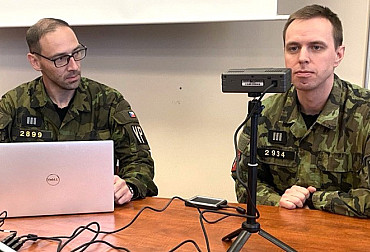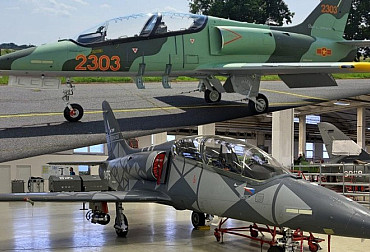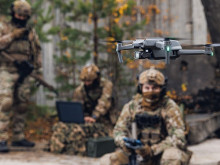Krauss-Maffei Wegmann: We visited the place where Leopards are born
The Ministry of Defence recently officially announced that the Czech Republic will receive Leopard 2 tanks from Germany. The two sides will also begin discussions on the possibility of acquiring up to 50 Leopard tanks for the Czech Army in the coming years, in the most modern version 2 A7+. The manufacturer of the Leopard 2 tanks is the Munich-based company KMW (Krauss-Maffei Wegmann) and it is this company that the Czech defence industry should cooperate with in the event of the acquisition of new Leopard tanks for the Czech Armed Forces. Therefore, we took advantage of the invitation and visited the company personally.
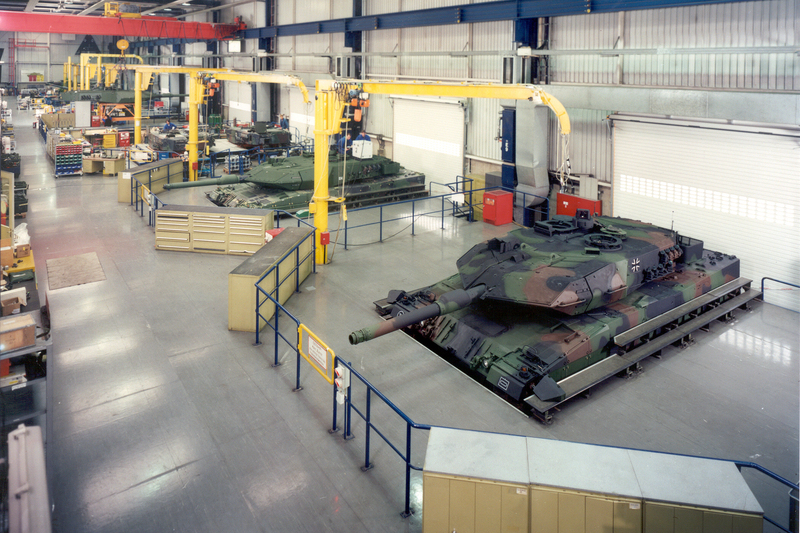 Picture: The manufacturer of the Leopard 2 tanks is the Munich-based company KMW (Krauss-Maffei Wegmann) and it is this company that the Czech defence industry should cooperate with in the event of the acquisition of new Leopard tanks for the Czech Armed Forces. | KMW
Picture: The manufacturer of the Leopard 2 tanks is the Munich-based company KMW (Krauss-Maffei Wegmann) and it is this company that the Czech defence industry should cooperate with in the event of the acquisition of new Leopard tanks for the Czech Armed Forces. | KMW
The acquisition of Leopard 2 tanks for the Czech Army has been speculated in the media for some time, when it was discussed exactly which version would be involved and under what conditions the tanks would be acquired. All, sometimes fantastic, theories were dispelled on Wednesday, May 18, by the Ministry of Defence of the Czech Republic, which announced that it will receive 15 Leopard 2 A4 tanks (14 combat and one recovery tank) from the Germans, including spare parts and ammunition provided by the German defence industry. The contract is expected to be signed during the summer. The first Leopard 2 A4 tank will then be delivered no later than six months after the signing, with the others to follow shortly thereafter. The Ministry of Defence expects that the donated tanks will be upgraded to the 2 A7 version in the future. This year, as part of the transition to the new platform, it is also planned to start training Czech soldiers in Germany and then to intensify the combined training of Czech and German tankers on our territory.
The Ministry of Defence has also announced that it will negotiate the acquisition of up to 50 additional Leopard tanks in the latest version 2 A7+, in various modifications, which the Ministry would like to acquire in the coming years.
"Germany has long been our key economic partner. However, this has not been the case for a long time in the field of defence and we want to change this, not only in the field of tanks but in bilateral cooperation in general. I believe that this will make our army stronger and our country safer," said Minister Černochová.
History of KMW
The German company Krauss-Maffei Wegmann has had experience in tank production since the end of World War I, when the then Wegmann & Co. produced the first German tank, the K-Wagen, which did not, however, take part in the war. The same company was then one of the manufacturers of the Panzerkampfwagen VI Tiger and Tiger II tanks during World War II. During World War II, Krauss-Maffei AG focused on the production of the Sd.Kfz. 7 and Sd.Kfz. 8 half-track artillery tractors. Subsequently, both of the above companies designed and produced the West German Leopard 1 main battle tank (Krauss-Maffei AG produced the chassis and Wegmann & Co produced the turrets), which entered service in 1965. This tank then served in many other armies besides the German army. In total, over 4,500 machines were produced. Another joint venture between Krauss-Maffei AG and Wegmann & Co was the Leopard 2 tank, which entered service for the first time in 1979 and is still in service in various versions today. Since 1999, the Leopard 2 tanks have been produced under the Krauss-Maffei Wegmann (KMW) banner. In addition to tanks, KMW is involved in the production of Puma infantry fighting vehicles, the PzH 2000 tracked self-propelled howitzers and MARS tracked rocket launchers, tracked self-propelled anti-aircraft systems and various wheeled vehicles. KMW also provides training and simulation facilities.
Leopard 2
Leopard 2 tanks are the only modern main battle tanks in production in Western Europe today. Over 3,500 of them have been produced to date and are in service in 19 countries. Just to illustrate, for example, the American M1 Abrams tanks serve in 7 countries, the British Challenger 2 tanks and the French Leclerc machines serve in 2 countries. The development of the various versions of the Leopard 2 tanks has taken place or is taking place in two dimensions - new production and the modernisation line. For example, the Strv 122 (Sweden), Leopardo 2 (Spain), Leopard 2 A7+ (Qatar) or Leopard 2 A7HU (Hungary) tanks are considered as new production. The future Leopard 2 A7+ tanks for the Czech Army should be included among the new production. Within the modernisation line, the Leopard 2 A5, Leopard 2 A6M, Leopard 2 A7 and Leopard 2 A7V tanks for the German Army, or the KPz 87 WE (Switzerland), Leopard 2 A4M (Canada) or Leopard 2 A5 DK (Denmark). Currently, the German Army is using Leopard 2 tanks from A5 and later. Interestingly, although the original development of the Leopard 1 and 2 tanks was funded by the German Government, the development of the Leopard 2 A7 version was already funded by KMW.
Leopard 2 in its latest A7+ version has a new 120 millimetre L55A1 cannon, modular reinforced armour, improved handling, better fire control, upgraded electronic systems and improved optoelectronics. Another safety feature worth mentioning is the blow panel mounted on the roof of the tank at the rear of the turret, where the ammunition storage is separated from the crew compartment by a sliding armoured bulkhead. A protective plate placed above the ammunition box then allows the ammunition explosion to be directed upwards in the event of an explosion, thus limiting the blast pressure on the bulkhead between the ammunition box and the crew compartment. Thanks to this plate, the tank crew is thus better protected from the consequences of the explosion, when there is no risk of tearing off the entire tank turret, as we can often see recently with Russian tanks fighting in Ukraine.
The individual components of the Leopard 2 tank are manufactured directly at KMW (e.g. tracks and other components are manufactured at the KMW foundry in Remscheid) or KMW buys them from German (e.g. Rheinmetall supplies 120mm L55 guns) or other suppliers (e.g. torsion bars are imported from Slovenia). Of course, other or extra components can be implemented into the Leopards at the customer's request, which is then logically reflected in the final price of the tank.
Production site visit
Throughout the tour of the KMW premises, we were accompanied by Thomas Fritzsch, KMW Sales Director for Central and Eastern Europe, who showed us the various production/assembly and testing halls where we could learn more about the production process and modernization of Leopard 2 tanks. The production of one Leopard 2 tank takes several months, and if not completely new tanks are produced, but older versions are used (e.g. A4, A5), these original pieces are completely disassembled, individual parts are refurbished or upgraded, everything is then assembled and practically a new tank leaves the factory.
In the halls, besides leopards, other equipment for the German army and for foreign clients could be seen.
Approximately 1,800 people currently work at KMW in Munich (KMW employs around 3,700 people in total) and, given the current increased interest in military technology, the company is always looking for new employees.
Our visit also included a dynamic presentation of the Leopard 2 tank on the test range.
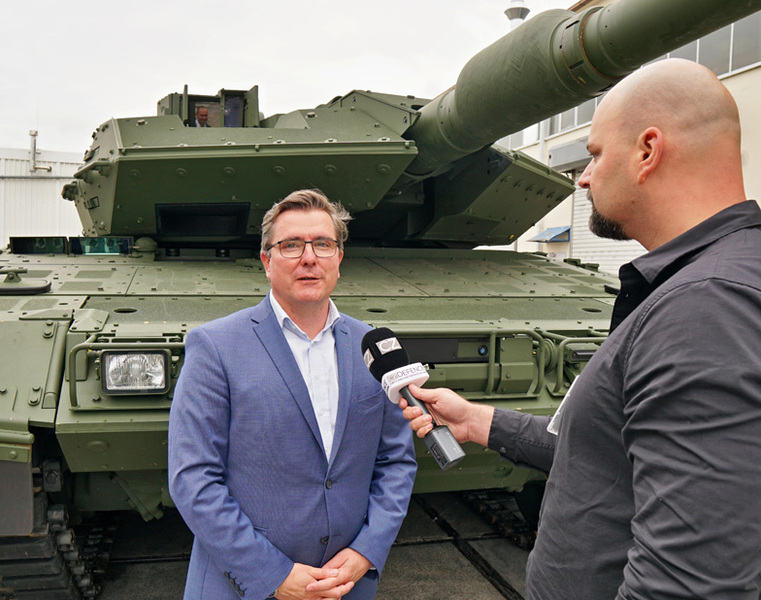 Picture: Moment from an interview with Thomas Fritzsch, KMW Sales Director for Central and Eastern Europe | CZ DEFENCE
Picture: Moment from an interview with Thomas Fritzsch, KMW Sales Director for Central and Eastern Europe | CZ DEFENCE
Leopard 2 for the Czech Armed Forces
In the case of the donated Leopard 2 A4 tanks, these will be delivered by the German government within the German defence industry, with Germany bearing all relevant costs. However, KMW will not be the supplier of these tanks as it does not have any stored Leopard 2 A4 tanks. If necessary, the donated Leopard 2 A4 tanks can be upgraded to the 2A7 version, which, as mentioned in the introduction of the article, the Czech Ministry of Defence is reportedly counting on.
The new Leopard 2 A7+ tanks should then be completely newly produced and it is likely that the approximately 50 tanks declared so far for the Czech Armed Forces will be part of a larger order for this tank version. KMW is then reportedly able to deliver the first Leopard 2 A7+ tank to the Czech Republic within three years of signing the contract. In any case, it is already clear that our tankers will receive very effective and comfortable machines in the future.
It should also be noted that the Leopard 2 tank crew consists of 4 people - commander, gunner, loader and driver. Compared to the crew of the T-72 M4CZ tanks currently serving in our Army, this will add the position of loader.
The Czech defence industry should of course participate in the production of the new Leopard 2 A7+ tanks, using existing production facilities for heavy military equipment. Czech industry should then also be responsible for the repair and maintenance of these tanks.
With regard to training and simulation facilities, there is either the option of using one of the existing or under construction KMW facilities (Qatar, Hungary) or a training and simulation centre may be built in the Czech Republic. These centres will then be used for driver training, simulation of various combat situations, command and tactics and maintenance training. Interestingly, although the individual trainees are physically separated from each other (e.g. training of Leopard 2 and PzH 2000 crews), they can be part of one simulation and cooperate together in a simulated combat.















